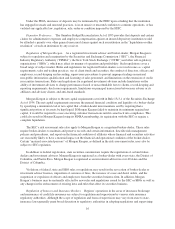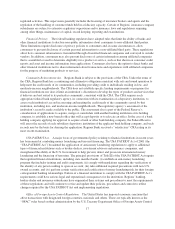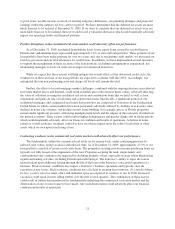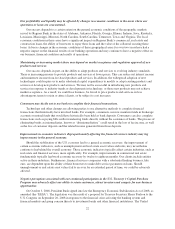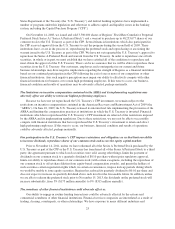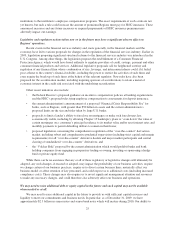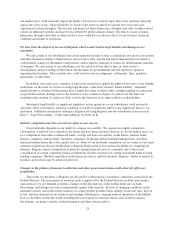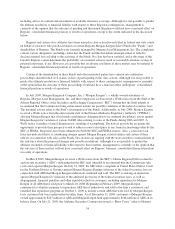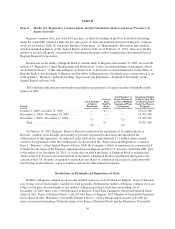Regions Bank 2009 Annual Report Download - page 40
Download and view the complete annual report
Please find page 40 of the 2009 Regions Bank annual report below. You can navigate through the pages in the report by either clicking on the pages listed below, or by using the keyword search tool below to find specific information within the annual report.raise additional capital, if needed, will depend on, among other things, conditions in the capital markets at that
time, which are outside of our control, and our financial performance. The ongoing economic slowdown and the
loss of confidence in financial institutions may increase our cost of funding and limit our access to some of our
customary sources of capital, including, but not limited to, inter-bank borrowings, repurchase agreements and
borrowings from the discount window of the Federal Reserve.
We cannot assure you that such capital will be available to us on acceptable terms or at all. Any occurrence
that may limit our access to the capital markets, such as a decline in the confidence of debt purchasers, depositors
of Regions Bank or counterparties participating in the capital markets, or a downgrade of our debt rating, may
adversely affect our capital costs and our ability to raise capital and, in turn, our liquidity. An inability to raise
additional capital on acceptable terms when needed could have a materially adverse effect on our business,
financial condition and results of operations.
We are a holding company and depend on our subsidiaries for dividends, distributions and other payments.
We are a legal entity separate and distinct from our banking and other subsidiaries. Our principal source of
cash flow, including cash flow to pay dividends to our stockholders and principal and interest on our outstanding
debt, is dividends from Regions Bank. There are statutory and regulatory limitations on the payment of dividends
by Regions Bank to us, as well as by us to our stockholders. Regulations of both the Federal Reserve and the
State of Alabama affect the ability of Regions Bank to pay dividends and other distributions to us and to make
loans to us. Due in large part to the significant loss recorded at Regions Bank during the fourth quarter of 2008
and losses during 2009, under the Federal Reserve’s rules, Regions Bank does not expect to be able to pay
dividends to us in the near term without first obtaining regulatory approval. If Regions Bank is unable to make
dividend payments to us and sufficient cash or liquidity is not otherwise available, we may not be able to make
dividend payments to our common and preferred stockholders or principal and interest payments on our
outstanding debt. See the “Stockholders’ Equity” section of Item 6. “Management’s Discussion and Analysis of
Financial Condition and Results of Operation” of this Annual Report on Form 10-K. In addition, our right to
participate in a distribution of assets upon a subsidiary’s liquidation or reorganization is subject to the prior
claims of the subsidiary’s creditors.
If we experience greater credit losses than anticipated, our earnings may be adversely affected.
As a lender, we are exposed to the risk that our customers will be unable to repay their loans according to
their terms and that any collateral securing the payment of their loans may not be sufficient to assure repayment.
Credit losses are inherent in the business of making loans and could have a material adverse effect on our
operating results. Our credit risk with respect to our real estate and construction loan portfolio will relate
principally to the creditworthiness of corporate borrowers and the value of the real estate serving as security for
the repayment of loans. Our credit risk with respect to our commercial and consumer loan portfolio will relate
principally to the general creditworthiness of businesses and individuals within our local markets.
We make various assumptions and judgments about the collectability of our loan portfolio and provide an
allowance for estimated credit losses based on a number of factors. We believe that our allowance for credit
losses is adequate. However, if our assumptions or judgments are wrong, our allowance for credit losses may not
be sufficient to cover our actual credit losses. We may have to increase our allowance in the future in response to
the request of one of our primary banking regulators, to adjust for changing conditions and assumptions, or as a
result of any deterioration in the quality of our loan portfolio. The actual amount of future provisions for credit
losses cannot be determined at this time and may vary from the amounts of past provisions.
We are exposed to intangible asset risk; specifically, our goodwill may become impaired.
In the fourth quarter of 2008, we determined that a portion of our goodwill was impaired and recorded a
non-cash goodwill impairment charge of $6.0 billion. A significant and sustained decline in our stock price and
market capitalization, a significant decline in our expected future cash flows, a significant adverse change in the
26


